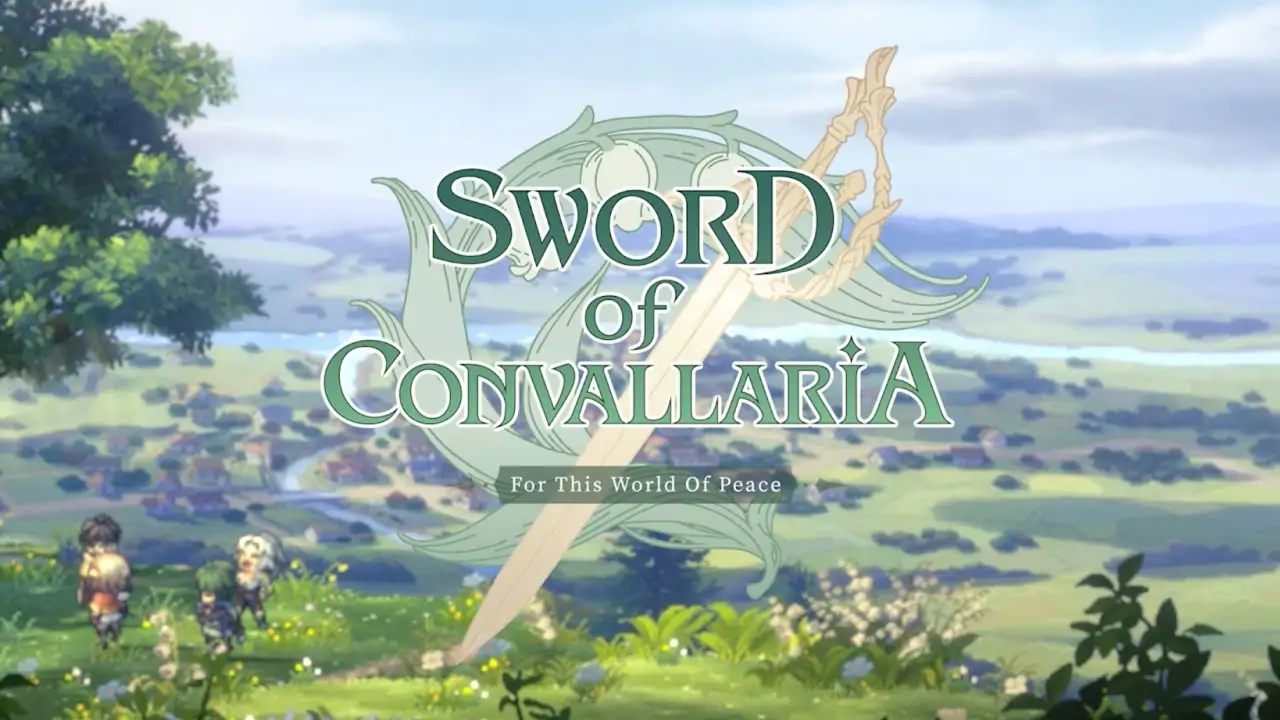Sword of Convallaria is a tactical RPG and mercenary company manager with a self-described NeoPixel art style. Its combat is reminiscent of games such as Final Fantasy Tactics and Fire Emblem and aims to have a multi-pathed path story with a wide roster of heroes able to be recruited and summoned on the battlefield, alongside engaging squad-based skirmishes. But how well does the Sword of Convallaria achieve this?
So Sword of Convallaria is what’s called a gacha summoner. You get units by pulling summons using in-game and, often, real-world currency and a gacha summoner; one of the big points is how the game pushes you into spending money on rolls for your units, heroes, or waifus, or whatever it is you would like to call them. Since this is just a demo build, I will not be going into the market or costs except for a bit later in the campaign portion of this preview later on.
Presentation
I don’t think it’s an exaggeration to say that Sword of Convallaria is stunning to look at. However, I also have a weakness for pixel art mixed in with modern fidelities such as ambient lighting and particle effects. Certain rooms will be adorned with ornate and detailed furniture and small animals such as birds or cats playing in idle animation, all in pixel art. The same room can then be lit by a fireplace with modern particle effects or light radiating out from the windows to light up a room. It reminds me a lot of what “Octopath Traveler” was able to achieve, blending traditional pixel art and modern visual effects to create stunning visuals.
Much of the game takes place in a small town called Convallaria, and it is also fully fleshed out with small streets to navigate on or cliffsides to overlook. Every location acts as a diorama. A pointless diorama. When locations have NPCs with dialogue to deliver or quests, the player can just navigate directly to the NPC from the menu, but it doesn’t take away from what the art team was capable of if you wish to just walk around.
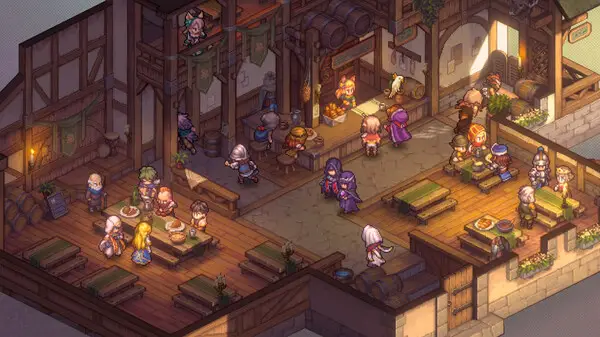
Every Talkable NPC also gets a character profile drawn of them, but instead of being in pixel art, it’s done in a soft pastel, anime style, which is the best way my art-limited brain could describe. But the profiles and their designs often e of the generic featureless designs in alot of more forgetably produced isekais. The line work and facial expressions are far superior here, but I think I would have preferred if they stayed with pixel art for the profiles.
Character designs can be hit or miss. Many Recruitable characters are just “mercenary pikemen, and it’s just a dude in a spear, wearing a shirt and a bandana, which sucks because I’m a history nerd. And some nice dressed up gambesons, or mail coifs, or literally any decorations/armor would make some of these more basic units stand out, or maybe even local clothing, just give me something!
Of course, this criticism melts away once faction units are introduced, and we get a range of characters, ranging from the king’s army who sort of have a revolutionary era flair with their coats and tricorns, to your standard medieval knights in full plate and kettle helm, to dark cultists and white clothed healers. And when a character design hits it, HITS.
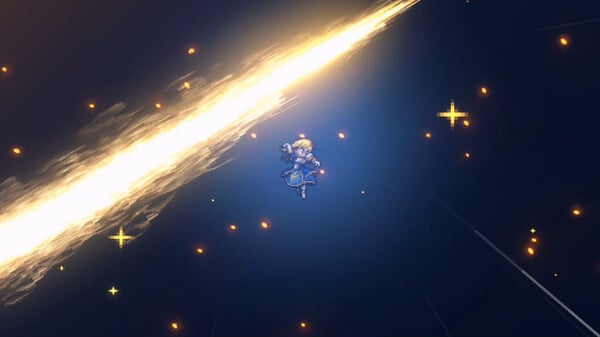
My favorite is Gloria. She’s a high-ranking member from the Union of Knights States who summons a flowing battle spear and flag made of light that flows with the wind. One of her specials is a well-animated sequence of her planting the flag down on a point on the map and dealing heavy damage to all enemy units nearby, making her one of my favorites whenever she shows up, both for her abilities and battle flair.
Functionality and PC Ports
Let’s talk about ports. The key I was given was for Steam for my PC, meaning all my complaints will be for the PC version of the game. It’s readily apparent that all of the controls were built with touch screen in mind and then the game was ported to PC with little change given how players would interact with the game. When summoning units, You physically have to drag the cards down like you would on a phone.
Walking around the world requires you to click where you’re going like a school mmo, or you can hold down left click and open a 360 joystick mobile controller to move around. Gross! These minor control hangups don’t impact the overall game since it’s mostly a tactical RPG, but not having better controls in the picturesque hills and town not only incentivized me from exploring but also gave a feeling of cheapness. Cheapness is a harsh word, but it is the only way to describe the feeling of playing a game where you KNOW the game is clearly built without any real changes for another platform.
There were some other oddities that arose during my playthrough: Sometimes, fully animated cutscenes would play when huge story moments occurred, and I’m sure they would have looked great if they weren’t at 240p. Most likely, the resolution is set to play on phone-sized screens, and I had trouble scaling up for my PC monitor. Also, combat could be much faster if the PC port allowed for quick commands or key binds for accepting movement instead of making everything a clickable UI element as if I’m on the phone.
Another weakness of the demo is its translation. Sometimes, I feel like I could go a full cutscene with no problems, and then suddenly, every other line is using the incorrect tense for verbs or not using proper conjunctions. It’s not severe enough to where I miss the point of the cutscene, but it does undercut emotional points by making dialogue feel stunted and blunt.
A perfect example is a line I copied here that describes one of the major factions in the game: “Its full name is “the Union of Knights’ States”, which is a national alliance composed of 13 Knight State with great military power”. Or when a character complements another character with “You are ingenuity.”
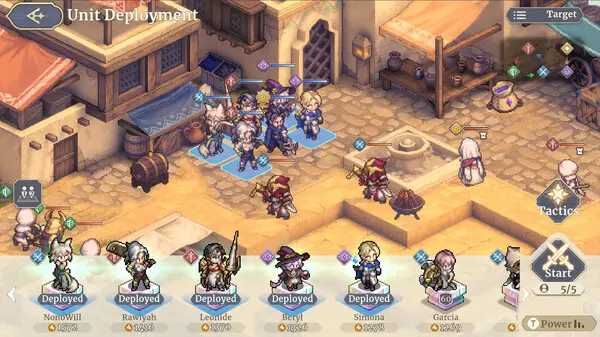
Gameplay
Sword of Convallaria is broken into 3 modes, but currently, in the demo, only two are available. The first is Fates Journey. The game opens with a failed escape out of a city wide riot, leading to your death. In Fate’s journey you’ll summon allies to help battle in a sort of limbo version of the events from your past to collect the ability to go back in time and change your fate.
It’s a little convoluted, but worse, it’s dull. It acts as a functional tutorial for the units, their combat types, environmental damage, and special abilities units get. The problem is this goes on for at least an hour or two and gives the impression that the game will be overly simplistic and brain-dead, but that just isn’t true. Thankfully this portion of the game is where all the gacha mechanics take place, as the rest of the preview will be covering the alternate story mode.
But while we’re on the topic of units and combat, let’s talk about that. A combat triangle decides combat. If you’ve played games like Fire Emblem or others, then you’re familiar with the mechanics, even if the units type names are daft. Defenders counter seekers (rogue), seeker counter breakers(a DPS class), and Breakers counter Defenders. Watchers who exist outside of the triangle can fill the role of support with lots of heals as well as magic or ranged damage and can counter Destroyers.
Destroyers are powerful mages with no counters except for the aforementioned Seekers. If a class counters another, it’ll receive less damage and deal more damage to the class it’s countering. It’s important to have a diverse team to fill each role and place them in strategic places; I wouldn’t want the wrong unit getting flanked or placing the counter to a boss on the wrong side of the map.
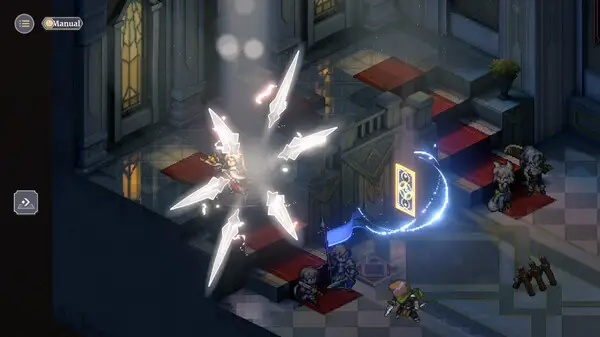
Equipment can be crafted or rewarded after a mission and given to units granting buffs to various stats. Units can also be leveled. Units gain a set amount of XP for each mission, so you don’t have to worry about some units over-leveling because they’re powerful and stealing kills from weaker units. Or you can leave them in the training ground in town, meaning after 1 – 2 weeks in-game time, they’ll receive massive gains, making it easy to level the units you want, even if you haven’t used them in a while, but keeping a unit leveled isn’t the only trait to be managed. Each unit has stamina, but it goes down after every mission they use and drains significantly if defeated in battle. If a unit’s stamina drains to 0, they won’t be able to be used for missions and combat and must take time to rest in the haven in town.
Units can also differentiate themselves with skills. Units come with 2 base skills but 3 more can be added, either being unique attacks, or passives that can buff or heal themselves / teammates. You can further augment troops with equipment, two pieces each. One of my favorite units is a recruited hangman seeker, who is granted a special ability to dash across the battlefield at a greater pace and gives high damage boosting gear so she can cut her away across the battlefield, killing any unit she comes across, except her one counter, defenders.
Combat can also use the terrain where knocking opponents off the map or into water can kill them. The terrain can create chokepoints or passageways, and occasional explosive barrels and boulders can be used. Boulders will roll down any direction they were hit to deal serious damage while explosive barrels deal AOE. with various units, gear, skills, and terrain itself, Sword of Convallaria adds enough to keep each engaging enough that I rarely feel the need to click the dreaded. “Auto battle” button that kills the flow of many games. Once I’m in the habit of using auto battle, the gameplay loses me, and I get bored extremely fast,
But I think it’s high time I talk about the town, the heart of Sword of Convallaria’s campaign for me. Convallaria, as a town, has a sanctuary for receiving temporary buffs, a luxite workshop for gaining permanent extra abilities to use in combat as a commander ability, a forge for making gear, a tavern for recruiting new units, a town square for shops with supplies and gear.
The aforementioned training ground can rapidly level a unit or teach it a new skill, and the haven restores a unit to full stamina. Many of the buildings in town can be upgraded using coins or resources. Friendly factions can also give quests that require supplies and coins.
So, in between each mission, it’s a delicate dance of keeping resources to balance upgrades with using the forge to craft new weapons for your units. But keeping a unit in the haven or training ground prevents them from being used, so you’re also balancing a rotating squad of units trying to keep them all powerful and leveled, but also capable of picking the workload from resting or occupied.

Management and Politics
Of course, that leaves us with the choice of mission. Each mission can have a varied goal, such as defeating everyone, making it to a certain point on the map, or even defending a point. However, each mission grants different rewards and has different levels of difficulty. There’s also usually an overarching goal that has to be completed in a timespan, like “Support the Union of Knights” or “bring stability to Irea.” meaning you have to balance meeting the main objective, picking missions that grant supplies or coins to keep your current units well equipped, while also taking on challenges you know you can beat, lest you waste time and unit strength on a mission that wasn’t worth it. Some missions are also caravans, where you can assign units to guard the caravan for large sums of resources or coins, but give up being able to use them in combat.
There’s not much to the characters or the story until you get past the tutorial and Fates Journey, which also really creates a feeling of stagnation the first few hours. The game feels overly simplistic at first, but once the town opens up and you have so much to manage, it feels like you’re managing a mercenary company, managing the Sword of Convalaria!
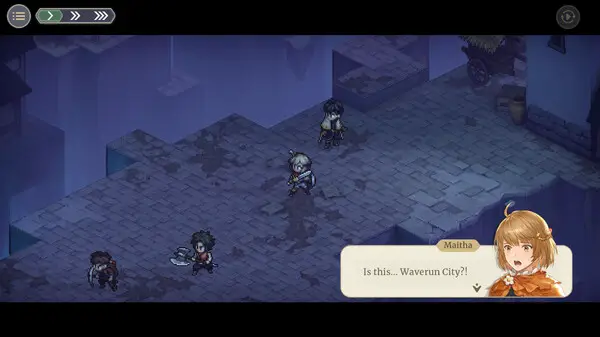
Onto the story and politics. It’s up to you how much the characters sync with you is gonna determine the story, although you don’t get to know them at the beginning, and there’s a lot of exposition until you get past the Fates Journey part of the game. Some of the big reveals don’t land only because they’re pretty predictable. But as an anti-war story, it’s pretty great.
Watching characters learn or change over time from the story helps maintain the idea that I’m managing a company in a living, breathing town caught in the middle of a brewing great war. There are also side events that can happen, my favorite being a drunk who harasses some of the Foxgirl natives from Vlder and ends up mysteriously dead the next day. But during the cutscene, you learn more about tribe, culture, and performance, and they give a dance customary from their culture.
One of the story’s big factors is the country’s politics. There’s the civil war in Iria brewing between rioters and the corrupt and brutal authoritarian Iria government, especially with the elite troops and secret police known as the hanged man. But also nearby countries ready to swoop in and devour the sick man of Rodinia that is Iria, such as the Papal States and the Union of Knights States, as well as a dark cult brewing in the slum mines.
The politics feel like they’re trying to go for a deep political intrigue, but while there’s a lot of power, it’s not always so complex. The papal states are using their religion and power to steal irias resources during this instability. And the knights are trying to help, but they have alternate goals, understanding these politically goals feels less complex and more simple and straightforward, not something you want in a political drama.
Final thoughts

Overall, I had a great time with Sword of Convallaria, and I’m interested to see where the story goes from here, as well as the alternate timelines the game advertises with its branching story paths. It seems many of the summoning mechanics are for the Fates Journey and leave the story mode Spirals of Destiny alone for the most part, meaning a decent story with engaging management mechanics in a fantastic art style for free, perhaps. It’s hard to say how monetization will go at launch, but I have high hopes that Sword of Convallaria will be the next free-to-play game you try out.

